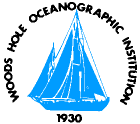
|
|
Contact
| WHOI Internal Home |
|
RAFOS Float Processing at Woods Hole Oceanographic Institution
Christine M. Wooding
Heather H. Furey
Marguerite A. Pacheco
BACKGROUND
Oceanographers have used acoustically tracked sub-surface floats since
the 1960's. There have been many improvements, but tracking them remains
a challenge because the submerged locations are only available indirectly.
In the early 1980's, Bill Schmitz established a small group at
WHOI dedicated to using acoustic floats to measure ocean currents.
Tracking software was adapted by Breck Owens from that used by
Tom Rossby at URI. During the next 14 years around 150 SOFAR floats
were tracked by the group. In order to decrease the cost of float
experiments, Rossby developed the RAFOS float, which is smaller and
cheaper than SOFARs and could be used in larger numbers. As part
of WOCE, Breck Owens and Jim Valdes developed an improved version
which was deployed in large numbers as part of the Brazil Basin
Experiment starting in 1994. WHOI scientists have now tracked
over 350 RAFOS floats, have 50 currently deployed, and have more
planned to deploy in the future.
When we switched to RAFOS floats we modified the SOFAR processing
and tracking software to track RAFOS floats. Recently it was decided
to switch to a newer MATLAB-based tracking scheme. ARTOA-II is a single
integrated package of Matlab routines which makes it possible to track a
float in a single session. It represents a complete overhaul of previous
programs and has been developed in stages by Claudia Schmid (at IFM, Kiel),
Martin Menzel (IFM, then IFREMER in Brest), and Olaf Boebel (IFM, URI)
(Anderson-Fontana et al., 2001). Heather Furey and Roger Goldsmith (WHOI)
have worked with Olaf Boebel (now at AWI) to be sure the package includes
options such as least-square tracking and doppler-shift calculations.
The current tracking program, ARTOA-II, takes the float from raw
data through final track. By having all the steps in a single program,
one can go back and correct the track by making changes at any point
in the process - removing or replacing a bad point in the times-of-arrival
(TOA) series; adding or subtracting a time-constant or drift to the
float or any sound-source. The results can be compared and the best
one selected. |
|
|

